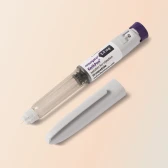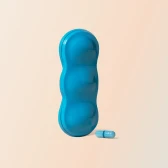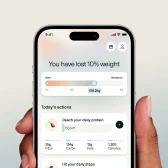Feeling tired, sluggish, or like you’ve lost your edge? Low testosterone could be the reason and it’s more common than you might think.
Testosterone replacement therapy (TRT) is a treatment for men dealing with these hallmark symptoms of low testosterone. Here’s how it works, what the benefits are, and when it might be worth considering.
What does TRT do?
TRT replaces missing natural testosterone with testosterone medication (in the form of injections, creams and gels, or tablets).
TRT might be prescribed when a blood test flags low testosterone levels and you have some of the symptoms of low T to match, such as:
- Low mood
- Low energy
- Brain fog
- Reduced muscle mass
- Low libido or sex drive
- Erectile dysfunction
- Poor sleep
Because testosterone affects almost every system in the body, TRT doesn’t just reverse symptoms - it can bring wider benefits too, including:
- More confidence
- Improved muscle mass and strength
- Stronger bones
- Better blood sugar control
How to know if you need TRT?
Most men look into TRT because they feel low in energy, mood, libido or strength. But these symptoms aren’t always due to low testosterone, which is why getting a blood test to check your levels is key before you start TRT.
For an accurate diagnosis, it’s best to have two blood tests at least a week apart. Your doctor will assess your levels, along with your symptoms, before deciding whether TRT is the right fit.
Low testosterone is surprisingly common. Estimates vary, but around 2 to 5% of men overall, and up to 40% of men over 45, have clinically low testosterone. Low testosterone becomes more likely with age. From around 30, levels of total testosterone decline by about 1% per year. Free testosterone - the active form your body can use - falls even faster due to higher levels of SHBG (a protein that binds testosterone).
Other causes of low testosterone include:
- Testicular injury or infections (e.g. mumps)
- Brain injury or pituitary problems
- Chronic alcohol or opiate use
- Diabetes
- Genetic conditions (e.g. Klinefelter’s, Kallmann’s)
- Haemochromatosis (iron overload)
How long does TRT take to work?
Everyone’s different. So how long TRT takes to work varies from person to person and depends on the type of treatment you choose.
Short-acting testosterone injections and creams often give the fastest results, while long-acting injections might take a little longer to show the benefits.
But generally, most men notice improvements within the first three months of treatment. At Voy, 90% of men on a TRT plan see symptom relief within 12 weeks.
Here’s a typical timeline:
- 1 to 6 weeks: Some men notice improvements in mood, energy and sex drive within weeks.
- 3 to 6 months: By this stage, most men have their treatment plan fine-tuned. Any issues with raised estrogen - which can get in the way of progress - are usually under control. The main symptoms of low testosterone often improve, and many men notice extra benefits like less body fat, more muscle, and greater strength. Confidence, focus and drive also tend to pick up. TRT can boost red blood cell levels in men with anemia, improving energy and stamina during exercise.
- 6 months to 1 year: Here’s where many men notice changes to their appearance, such as more muscle mass, less body fat, and sometimes extra body hair. There should be noticeable improvements to low mood and brain fog, too.
- 1 year onwards: Some men take a little longer on TRT to see the full benefits, but at this stage, long-term effects such as stronger bones and sustained physical improvements come into play.
How to take TRT?
TRT has evolved, and there are now more options for treating low testosterone. The most common method is injections, since there are no absorption issues and your clinician can adjust your dose easily.
Knowing how and where to inject testosterone helps ensure each dose is safe and effective. See our subcutaneous injection guide for technique, sites, and needle tips.
There are different types of testosterone injections, and the main difference comes down to the “ester” (a modified version of the hormone that lasts longer in the body). Think of an ester as a small chain added to the testosterone molecule that controls how quickly the hormone is absorbed into your bloodstream. Short esters act fast but wear off quickly, while long esters take their time to release.
In practice, medium esters tend to work best. They usually mean 2 to 3 injections per week, which helps keep testosterone levels steady without big highs and lows.
At Voy, we recommend testosterone cypionate. It’s one of the most reliable options for keeping testosterone levels stable.
But if you don’t like needles, there are other options. TRT creams and gels can be applied to your skin and absorb over a few hours. They need to be applied twice daily for best results.
There’s also a new tablet form of testosterone, but it’s generally less effective compared to TRT injections.
Is testosterone replacement therapy safe?
The TRAVERSE trial, the largest study of its kind, found that TRT does not increase the risk of heart attacks, strokes, or prostate cancer. Men on TRT actually had lower mortality than untreated men with low T.
TRT isn’t totally risk-free, though. TRT increases the number of red blood cells your body produces, which can be great for energy levels, but it can sometimes cause your blood to become too thick, which increases the risk of blood clots. This is why monitoring your health with regular blood tests is important on any TRT plan, so that your doctor can manage TRT side effects if they occur.
Expert insights from Jeff Foster on TRT safety
"TRT can also reduce your fertility, as it suppresses your natural testosterone production. But if you’re planning on expanding your family and want to start TRT, there are fertility-preserving medicines such as HCG or clomiphene you can take alongside, or instead of, testosterone medication."
Medical Director Jeff Foster - Men’s Health & TRT Specialist

How to get testosterone replacement therapy in the UK
There are two routes for getting testosterone replacement therapy in the UK: through the NHS or with a private clinic.
The NHS provides a low-cost way of getting treatment, but access is slow and limited (to be eligible for TRT on the NHS, you generally need very low testosterone levels). The NHS doesn’t usually provide fertility preservation medicines or ways to manage high oestrogen levels.
Private clinics make TRT easier to obtain as they tend to treat at higher testosterone levels. They also have access to a greater range of treatment options, including oestrogen and fertility management. For example, some may offer alternatives like enclomiphene, which can help raise T levels while preserving fertility.
Private clinics are also more likely to have doctors who are more experienced in providing TRT than your GP.
With both routes to TRT, the main steps to starting treatment are:
- Initial blood test for testosterone levels
- Confirmatory blood test with comprehensive values tested for diagnosis
- Consultation with a clinician
- Prescription and treatment start
- Ongoing monitoring and management with follow-up consultation.
How much does testosterone replacement therapy cost?
TRT costs vary by provider, but you can expect to pay from £99 to £250 per month. Be aware that some clinics will not include medications, blood tests, clinic visits, consultations or injection supplies in their charges.
At Voy, subscriptions start at £99/month, covering medication, blood tests, consultations, fertility support, and more.
Getting started with TRT
TRT is safe, effective and can be life-changing for men with low testosterone. Modern research suggests it not only improves quality of life but may even extend it. With the right monitoring and medical support, most men can expect significant, lasting benefits.
Wondering if low testosterone is holding you back? Take our short quiz to see if TRT could help you get back to feeling your best.












